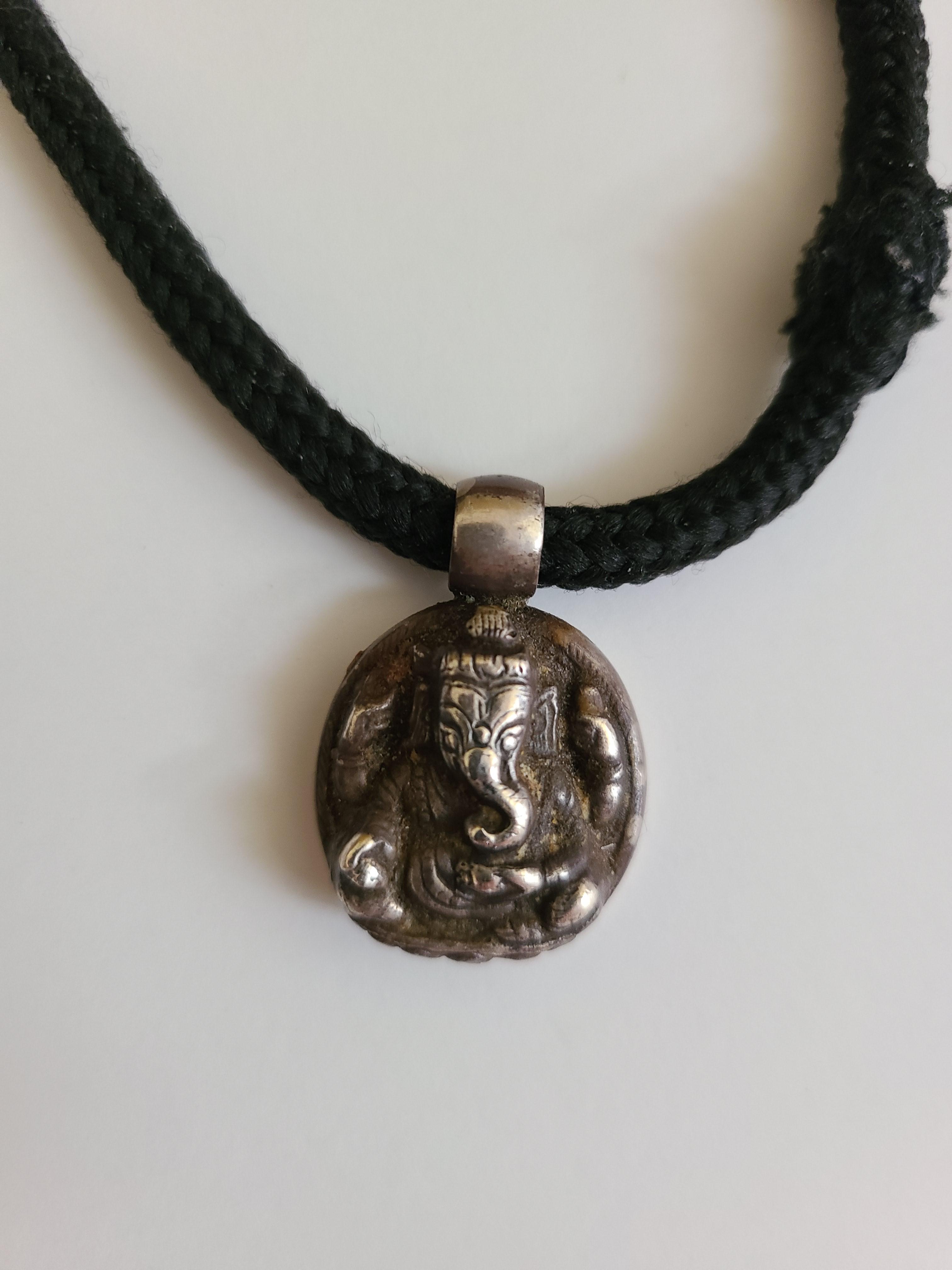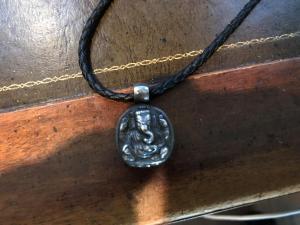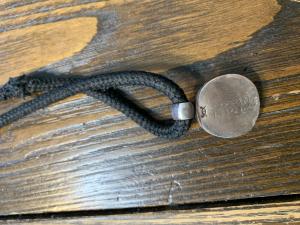Balinese Lord Ganesha silver locket
Ordered from Maru, made by others
Jewelry, Watches and Coins
Balinese silver locket with elephant-headed Hindu god Ganesha, on the black leather chain.
Indonesia learned the metal work crafts from Southern Chinese and Southeast Asian traders during the late Bronze age, several hundred years before the birth of Christ. These influences have been inferred from archeological digs that have uncovered dongson drums, jewelry, weapons and other artefacts with Southern Chinese and Southeast Asian symbols. Over time, the metalworking skills of the Indonesian people grew, added by continuous contact with outsiders seeking trade in spices and other items. Gold and silver, which continue to be mined in Indonesia, were in no short supply by the time the Majapahit Empire emerged in Java (1300s) and moved into Bali. By the time the empire had failed, Bali had become the center of Indonesia's silversmithing and gold work activities. Bali has had vigorous contact through trade with many cultures over many centuries. Indonesia was a Dutch colony as of 1602 and controlled much of the nation for 350 years. As such, Indonesians were influenced by European silverwork traditions and standards. The Balinese people, who are primarily Hindu, have a long and illustrious history. Arts and crafts are a significant part of their culture, and among their artisans is a community of highly skilled silversmiths. While silversmithing is practiced all around the island, there is a concentration of silversmiths in and around Celuk, a village in the south central part of the island.
Bali jewelers use traditional methods to produce their unique style of silverwork. The traditions have been handed down from the Southern Chinese and Southeast Asian artisans, and many of the patterns and motifs used today have similar designs. Many families in Bali can trace their silversmith and jeweler roots back to the Majapahit Empire and the invasion of the Javanese in the 16th century. In Bali, metal smiths are known as Pandai, a term that means both smith and clever. In legends in the area, the first goldsmith clans were taught their craft by the gods that were sent to earth to teach humankind civil behavior. Most jewelry in Bali, while originally gold, is now silver. The silver market is more popular worldwide, and the booming demand for exports dictates the production. There are both Balinese and Javanese traditions seen in what is known as Bali jewelry.
Balinese silversmiths tend to use small spheres of silver arranged in intricate patterns on a silver background. This technique is called granulation, and provides a sharp contrast between the darker background of the natural silver and the highly polished spheres of silver. Javanese silversmiths use fine filigree work on smooth, polished silver background. Most of the Bali jewelry on the market today is a combination of these two traditions. Bali jewelry patterns are intricate and eye catching, and often incorporate other metals such as gold as well as gems. The dark background of the unpolished silver serves to frame the patterns of the polished silver and highlight the gems and other metals used.
This locket depicts Ganesha (also spelled Ganesh and Ganapati), elephant-headed Hindu god of beginnings widely worshipped in Bali, who is one of the most important gods in Hindu mythology and the patron of intellectuals, bankers, scribes, and authors. His name means both “Lord of the People” (gana means the common people) and “Lord of the Ganas” (Ganesha is the chief of the ganas, the goblin hosts of Shiva). Ganesha is potbellied and generally depicted as holding in his hand a few round Indian sweets, of which he is inordinately fond. Ganesha is known for his ability to overcome anything to get what he wants. Ganesha is highly recognisable with his elephant head and human body, representing the soul (atman) and the physical (maya) respectively.
Many different stories are told about the birth of Ganesha, including one in which Parvati makes her son out of a piece of cloth and asks her consort, Shiva, to bring him to life. One of the best-known myths, however, begins with Parvati taking a bath and longing for someone to keep Shiva from barging in on her, as was his habit. As she bathes, she kneads the dirt that she rubs off her body into the shape of a child, who comes to life. But when Shiva sees the handsome young boy or when the inauspicious planet Saturn (Shani) glances at him, in some variants of the myth that attempt to absolve Shiva of the crime, he or one of his attendants cuts off the child’s head. When Shiva cuts off an elephant’s head to bestow it on the headless Ganesha, one of the tusks is shattered, and Ganesha is depicted holding the broken-off piece in his hand. According to this version of the myth, Ganesha is the child of Parvati, a child born despite Shiva’s negative intervention. Yet Ganesha is traditionally regarded as the child of both Shiva and Parvati.
On this locket Ganesha is depicted with his lower-right hand turned toward the audience in a gesture of "abhaya mudra" – or protection and fearlessness. It is a common representation of Ganesha in Bali. The Balinese ask Ganesha for help to make their plans a success as it it believed that he grants prosperity.
Bali jewelers use traditional methods to produce their unique style of silverwork. The traditions have been handed down from the Southern Chinese and Southeast Asian artisans, and many of the patterns and motifs used today have similar designs. Many families in Bali can trace their silversmith and jeweler roots back to the Majapahit Empire and the invasion of the Javanese in the 16th century. In Bali, metal smiths are known as Pandai, a term that means both smith and clever. In legends in the area, the first goldsmith clans were taught their craft by the gods that were sent to earth to teach humankind civil behavior. Most jewelry in Bali, while originally gold, is now silver. The silver market is more popular worldwide, and the booming demand for exports dictates the production. There are both Balinese and Javanese traditions seen in what is known as Bali jewelry.
Balinese silversmiths tend to use small spheres of silver arranged in intricate patterns on a silver background. This technique is called granulation, and provides a sharp contrast between the darker background of the natural silver and the highly polished spheres of silver. Javanese silversmiths use fine filigree work on smooth, polished silver background. Most of the Bali jewelry on the market today is a combination of these two traditions. Bali jewelry patterns are intricate and eye catching, and often incorporate other metals such as gold as well as gems. The dark background of the unpolished silver serves to frame the patterns of the polished silver and highlight the gems and other metals used.
This locket depicts Ganesha (also spelled Ganesh and Ganapati), elephant-headed Hindu god of beginnings widely worshipped in Bali, who is one of the most important gods in Hindu mythology and the patron of intellectuals, bankers, scribes, and authors. His name means both “Lord of the People” (gana means the common people) and “Lord of the Ganas” (Ganesha is the chief of the ganas, the goblin hosts of Shiva). Ganesha is potbellied and generally depicted as holding in his hand a few round Indian sweets, of which he is inordinately fond. Ganesha is known for his ability to overcome anything to get what he wants. Ganesha is highly recognisable with his elephant head and human body, representing the soul (atman) and the physical (maya) respectively.
Many different stories are told about the birth of Ganesha, including one in which Parvati makes her son out of a piece of cloth and asks her consort, Shiva, to bring him to life. One of the best-known myths, however, begins with Parvati taking a bath and longing for someone to keep Shiva from barging in on her, as was his habit. As she bathes, she kneads the dirt that she rubs off her body into the shape of a child, who comes to life. But when Shiva sees the handsome young boy or when the inauspicious planet Saturn (Shani) glances at him, in some variants of the myth that attempt to absolve Shiva of the crime, he or one of his attendants cuts off the child’s head. When Shiva cuts off an elephant’s head to bestow it on the headless Ganesha, one of the tusks is shattered, and Ganesha is depicted holding the broken-off piece in his hand. According to this version of the myth, Ganesha is the child of Parvati, a child born despite Shiva’s negative intervention. Yet Ganesha is traditionally regarded as the child of both Shiva and Parvati.
On this locket Ganesha is depicted with his lower-right hand turned toward the audience in a gesture of "abhaya mudra" – or protection and fearlessness. It is a common representation of Ganesha in Bali. The Balinese ask Ganesha for help to make their plans a success as it it believed that he grants prosperity.
Height: 2.125
Width: .75
Depth: .25
inches
Seminyak, Bali, Indonesia
Materials: silver and leather
The locket is made using was carving and casting. First, based on a drawing/picture the detailed was model is created. Once the wax carving is done, it goes to silversmiths, who then cast the wax, prepare a rubber mold and send the metal piece off to polishing, plating and finishing.




